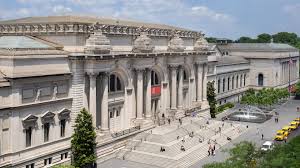Anchored at the edge of Central Park, the Metropolitan Museum of Art—known simply as The Met—stands as a colossus of human creativity on New York City’s Fifth Avenue. Spanning two million square feet, its gray facade conceals a labyrinth of galleries that house over 5,000 years of art, from Egyptian tombs to Renaissance altars to modern abstracts. Founded in 1870 by civic visionaries intent on rivaling Europe’s cultural capitals, The Met has grown into one of the world’s largest museums, its collections fed by donations, excavations, and the quiet ambition to preserve mankind’s story. Open daily, it hums with scholars, tourists, and locals tracing the threads of history.
Notable Insight: The Met’s iconic steps, often a perch for weary visitors, were never meant to be its front door—architects planned a grander entrance on Central Park, but budget cuts cemented the Fifth Avenue ascent as its enduring face.
How To Reach
The Met’s perch in Manhattan’s Upper East Side makes it accessible yet deliberate. From Midtown, the 4, 5, or 6 subway lines rumble to 86th Street, a ten-minute walk past brownstones to the museum’s steps—fares are $2.90 with a MetroCard.
Buses like the M1, M2, or M4 trundle along Fifth Avenue, stopping at 82nd Street for the same price. Drivers face slim parking odds; garages near 80th Street charge $30-$50 daily.
From Penn Station, a 20-minute cab ($15-$20) or the C train to 81st Street (transfer to a bus) works. Arrive early—lines swell by noon.
Places to Visit Within The Met
Egyptian Art Wing
The Temple of Dendur, a sandstone gift from Egypt reassembled in 1978, anchors this wing. Lit by a vast skylight, its carvings whisper of 15 B.C., free with admission ($30 for adults). Nearby, mummies rest in painted coffins, their bandages brittle with age, while the Book of the Dead unrolls on papyrus.
European Paintings
Velázquez’s Juan de Pareja and Vermeer’s Young Woman with a Water Pitcher gleam among 2,500 canvases. The galleries, hushed and golden, span Giotto’s stark saints to Monet’s water lilies—each room a step through centuries, included in the ticket.
Arms and Armor
Medieval knights’ steel glints under glass—visors dented, swords nicked from forgotten jousts. A 15th-century German suit, weighing 60 pounds, looms beside samurai blades, their hilts wrapped in ray skin. Entry’s seamless with your pass.
American Wing
Charles Wilson Peale’s portraits and Tiffany’s stained glass frame a courtyard where Emanuel Leutze’s Washington Crossing the Delaware stretches 21 feet wide. It’s a patriotic plunge into craft and ambition, accessible with admission.
Frequently Asked Questions About The Met’s Hidden Gems
What’s overlooked?
The Astor Court, a Ming Dynasty garden replica, hides in the Asian wing—serene with koi ponds, free with entry. The Musical Instruments gallery, with its 16th-century lutes, hums quietly.
Best quiet spot?
The Petrie Court Café offers river views and respite—coffee’s $5, solitude’s priceless. The Roof Garden, open May to October, frames Central Park for free with admission.
Oddest artifact?
A 3,300-year-old Egyptian cat sarcophagus, tiny and bronze, sits near the temple—cats were divine then. It’s part of the Egyptian haul.
Temporary exhibits?
Rotating shows—like 2025’s rumored Edo-period scrolls—cost extra ($15-$20 atop admission). Check the site; they shift quarterly.
Beyond the Highlights
The Met rewards the persistent. The Costume Institute, below ground, unveils Chanel gowns and Victorian corsets—its annual gala echoes in glass cases, free with entry. The Watson Library, open to researchers by appointment, holds 900,000 volumes; its hush smells of old leather. The Cloisters, a northern branch in Fort Tryon Park ($30 combo ticket), weaves medieval tapestries and stone arches into a monastic dream—take the A train to 190th Street. The main building’s rooftop, weather permitting, unveils a bar amid sculptures; a $12 cocktail pairs with skyline silhouettes. Lesser-seen Pacific Islands carvings, their wood warped by time, crouch in dim corners, whispering of lost voyages.
The Greek and Roman galleries harbor a marble kouros, its stare blank yet piercing, carved 600 years before Christ—an anchor to antiquity. The Islamic Art wing unfurls carpets dyed with saffron and lapis, their patterns dizzying in precision, while the African galleries cradle Benin bronzes, their kings cast in molten glory. Wander the Medieval Art halls, where reliquaries glint with saints’ bones, or pause at the South Asian statues—Buddhas hewn from schist, their calm unshaken by millennia. The Modern and Contemporary wing bristles with Rauschenberg’s combines, their junkyard poetry a jolt after older silences. Each turn reveals another layer, a quiet dare to keep looking.
Where to Stay
The Mark (Upper East Side): Polished luxury, five blocks away—$500-$700 nightly, marble baths included.
The Carlyle (76th Street): Art Deco grace, $400-$600, a whisper from The Met’s hum.
Hotel Wales (Madison Avenue): Cozy, historic, $200-$300—rooftop views seal it.
Hostelling International (103rd Street): Dorm beds for $50-$70, a budget trek worth the subway ride.
Final Reflections
The Met is no mere museum—it’s a crucible where time bends. Stand before a Greek amphora, its black figures frozen mid-dance, then pivot to a Pollock splatter, wild and raw; centuries collide in a single breath. Its halls echo with chisel strikes, brushstrokes, and the murmurs of makers long gone—yet the air feels alive, charged by the hands that shaped each piece. From the Etruscan chariot’s rusted spokes to the Mughal jade cups, every object insists on its story, daring you to listen.
To wander here is to walk through humanity’s mirror, flawed and radiant, its edges sharp with wonder. Step into the Lehman Wing’s cloistered rooms, where Renaissance bronzes gleam beside Venetian glass, and feel the weight of a collector’s obsession—or pause at the Asian scrolls, their ink faded but unyielding, mapping empires lost to dust.











